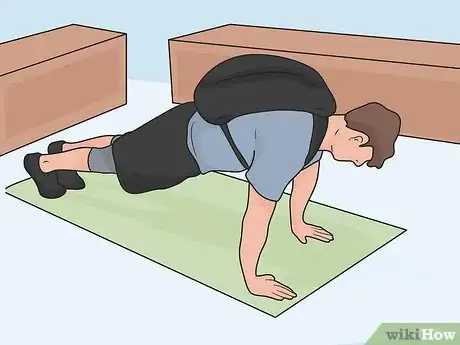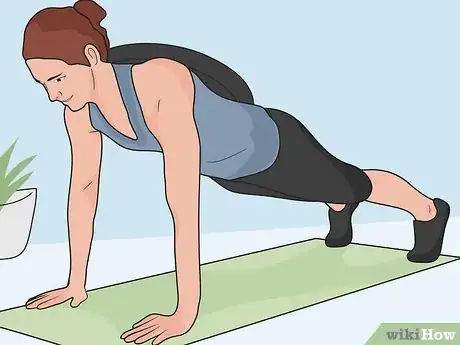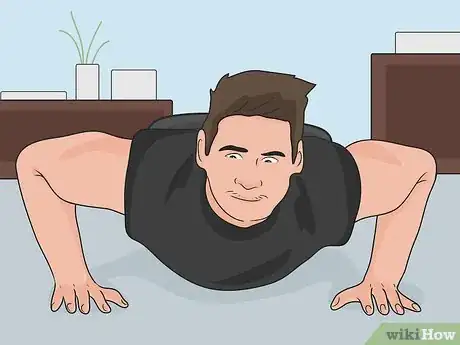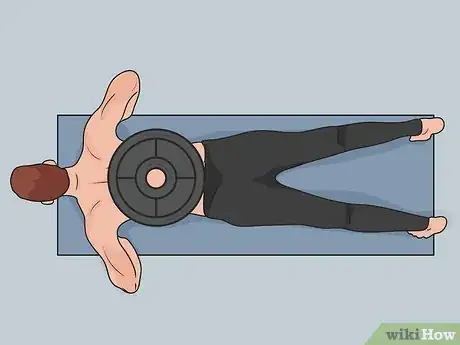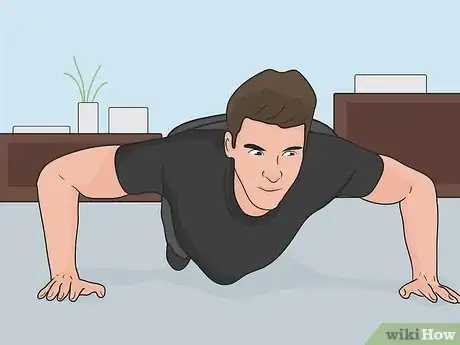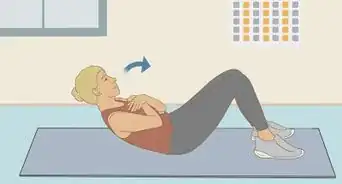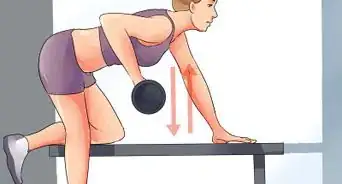This article was co-authored by Laila Ajani. Laila Ajani is a Fitness Trainer and founder of Push Personal Fitness, a personal training organization based in the San Francisco Bay Area. Laila has expertise in competitive athletics (gymnastics, powerlifting, and tennis), personal training, distance running, and Olympic lifting. Laila is certified by the National Strength & Conditioning Association (NSCA), USA Powerlifting (USAPL), and she is a Corrective Exercise Specialist (CES).
There are 7 references cited in this article, which can be found at the bottom of the page.
This article has been viewed 50,977 times.
Weighted push ups add weight to your back and shoulders, making this particular exercise even more challenging and beneficial if you’re looking to gain muscle. The most important thing when doing weighted push ups by yourself is safety. While you can’t stack multiple weights on your back without a spotter, that doesn’t mean you can’t still get in a good workout!
Steps
Choosing a Weighted Option
-
1Strap on a weighted vest to increase the intensity level of your workouts. A weighted vest is an excellent investment that can be used in lots of different exercises, but it especially comes in handy with solo weighted push ups. If you’re new to weighted push ups, get a vest that weighs somewhere between 4 to 10 pounds (1.8 to 4.5 kg); if you’re more experienced and know what weight you can handle, you can buy a vest up to 150 pounds (68 kg).
- Some vests come with additional weights you can add on as you get stronger. Consider investing in one of these if you plan on increasing the weight over time.
- Weighted vests focus the additional load on your shoulders and upper body, which means your lower back should be safe while you work out.
- If you don’t have good form and haven’t mastered an unweighted push up, wait to use a weighted vest. It can injure your body if you aren’t already a pro at regular push ups.
- In addition to benefiting your push-up practice, a weighted vest is great for cardio health. Try wearing it and taking a hike to get in an aggressive sweat-session.
-
2Use bands to challenge yourself and provide resistance during push ups. Long, thin resistance bands are easy to get in place by yourself, and there’s no risk of hurting your back or shoulders from a slipping weight. Wrap the band between your first finger and thumb on each hand, so it’s hooked across your palms. Position the band across your shoulders so that it’s even with your elbows, and then assume your push-up position.[1]
- Make sure the band is flexible enough that you can extend your arms while the band is across your shoulders.
- As you get stronger, switch to tauter bands for even more resistance.
- If you’re traveling, bands are a great option to bring along with you. They’re lightweight, but they can do a lot to help you get in a great workout.
Advertisement -
3Wear a backpack filled with water jugs for a makeshift weighted push up. Use a backpack with chest and shoulder straps so you can safely secure it around your body. Fill the backpack with as much weight as you want, then add towels to the empty space to keep the jugs from slipping around. Make sure to pack the backpack tightly with towels so the jugs stay balanced.[2]
- This method is fantastic if you’re at home without any special workout equipment.
- Water jugs or bottles make it easy to adjust how much weight you’re lifting. Use a jug for the main source of weight and add additional pounds with water bottles if you want to.
- Make sure to position the backpack up on your shoulders so that it doesn’t strain your lower back.
-
4Slide a weight around your back, balance it, and assume a push-up stance. For this method, use a round, flat barbell weight rather than dumbbells or hand weights. If you can’t lift the weight by hand, choose another method. Kneel on the ground and carefully grasp the weight behind your back. Balance it across your shoulders as you bend over, release one hand down to the floor, and then carefully get into position. Do your push ups while the weight balanced across your shoulders.[3]
- When you’re done with the push ups, put your knees back on the ground, reach up with one hand to balance the weight, then carefully raise your chest and grasp the other side of the weight before moving it to the ground.
- This option is riskier because you’re working with a heavy weight by yourself.
- You can generally only do this option on your own when using a single weight. It would be tough and potentially dangerous to load 2 or more weights on your back by yourself.
Performing a Safe Weighted Push Up
-
1Lower yourself onto your knees on an exercise mat. Depending on which method you’re using to do a weighted push up, get your weighted vest, band, backpack, or barbell weight in position. Make sure you have whatever you need to start exercising.[4]
- The exercise mat provides a little bit of cushioning for your knees and can be used in many other exercises.
- If you don’t have an exercise mat, use knee pads or even a pillow.
-
2Get down on the ground and place your hands shoulder-width apart. Position your hands so they’re palm-down next to your shoulders. Make sure your weighted option is positioned across your shoulders and isn’t putting a strain on your lower back.[5]
- If you decide the weight is too much, reduce it before you begin your push ups.
-
3Set your feet about shoulder-width apart and put your toes on the ground. Position your feet so the backs of your heels point toward the ceiling. At the most, set your feet 12 inches (30 cm) apart. The closer together you put your feet, the more challenging your push up will be.
- A great exercise to help get your body ready for push ups is the plank.
-
4Push your body up off the ground while keeping your back straight. From your shoulders to your heels, keep your body in a straight line. Extend your arms as if you’re pushing the ground away from your body.[6]
- Focus on using your core muscles and thighs to help stabilize your body. You have extra weight on your shoulders, so you’ll need to activate those muscles even more to keep your body straight.
- Don't let your hips sink down or come up too high. Your body should form a straight line from your shoulders to your toes.[7]
- If you experience lower back pain, elbow or wrist pain, or heavily shaking arms, you may be using too much weight. You should be able to do 8-10 reps without experiencing pain, though you should definitely feel a burn in your muscles.
-
5Lower your body back to the ground while maintaining a straight line. Either keep your elbows tucked next to your side to work your triceps, or bend them out away from your body to work your pectoral muscles. If you want, bring your body back to the ground before doing another push up. Or, you could lower yourself so that your face is about level with your elbows before resuming your set.
- Try touching something to the floor, like your nose, chest, or forehead.[8]
- If you feel like your form is about to break, go ahead and gently lower yourself to the ground and rest for a few beats. It’s better to go slow and be careful than to risk injuring yourself.
- If you can, try to pause for 2-3 seconds before pushing yourself back up. This extended hold works your core and can add a lot to your muscle gain.
- If you're having trouble raising back up, find something higher to put your hands on, like a coffee table or a bench.[9]
Expert Q&A
-
QuestionWhat are some mistakes to avoid when I'm doing a push-up?
 Laila AjaniLaila Ajani is a Fitness Trainer and founder of Push Personal Fitness, a personal training organization based in the San Francisco Bay Area. Laila has expertise in competitive athletics (gymnastics, powerlifting, and tennis), personal training, distance running, and Olympic lifting. Laila is certified by the National Strength & Conditioning Association (NSCA), USA Powerlifting (USAPL), and she is a Corrective Exercise Specialist (CES).
Laila AjaniLaila Ajani is a Fitness Trainer and founder of Push Personal Fitness, a personal training organization based in the San Francisco Bay Area. Laila has expertise in competitive athletics (gymnastics, powerlifting, and tennis), personal training, distance running, and Olympic lifting. Laila is certified by the National Strength & Conditioning Association (NSCA), USA Powerlifting (USAPL), and she is a Corrective Exercise Specialist (CES).
Fitness Trainer One of the biggest errors would be letting your hips be too high or too low when you're doing the push-up. Your body should form one straight line, and you should bring the whole thing up and down. Another mistake is not going deep enough. If you can, go all the way down and touch something to the floor, like your nose, chest, or forehead.
One of the biggest errors would be letting your hips be too high or too low when you're doing the push-up. Your body should form one straight line, and you should bring the whole thing up and down. Another mistake is not going deep enough. If you can, go all the way down and touch something to the floor, like your nose, chest, or forehead.
Warnings
- If you’re new to pushups, don’t jump straight into weighted ones! You could injure yourself and have to take a lot of time off before jumping back into your training.⧼thumbs_response⧽
- Avoid doing weighted push ups every single day. Your muscles need some time to rest and recover between workouts, about 48 hours, if possible.[12]⧼thumbs_response⧽
References
- ↑ https://youtu.be/cOFwFzzLFWw?t=17
- ↑ https://youtu.be/IVTlphq6EBY?t=87
- ↑ https://youtu.be/_9YqyFzAXB4?t=52
- ↑ https://www.acefitness.org/education-and-resources/lifestyle/exercise-library/41/push-up/
- ↑ https://www.acefitness.org/education-and-resources/lifestyle/exercise-library/41/push-up/
- ↑ https://www.acefitness.org/education-and-resources/lifestyle/exercise-library/41/push-up/
- ↑ Laila Ajani. Fitness Trainer. Expert Interview. 31 October 2019.
- ↑ Laila Ajani. Fitness Trainer. Expert Interview. 31 October 2019.
- ↑ Laila Ajani. Fitness Trainer. Expert Interview. 31 October 2019.
- ↑ https://www.silversneakers.com/blog/exercise-modifications-swaps-for-wrist-pain/
- ↑ https://www.acefitness.org/education-and-resources/lifestyle/exercise-library/41/push-up/
- ↑ https://www.acefitness.org/education-and-resources/lifestyle/blog/685/if-my-muscles-are-sore-from-previous-workouts-is-it-safe-to-exercise-them/


